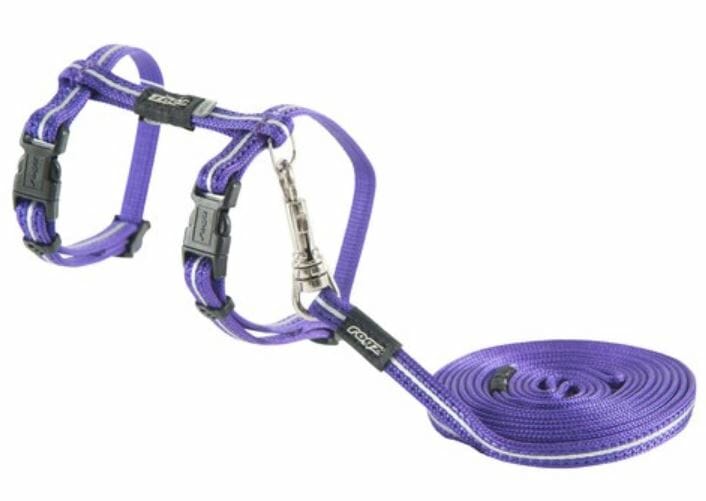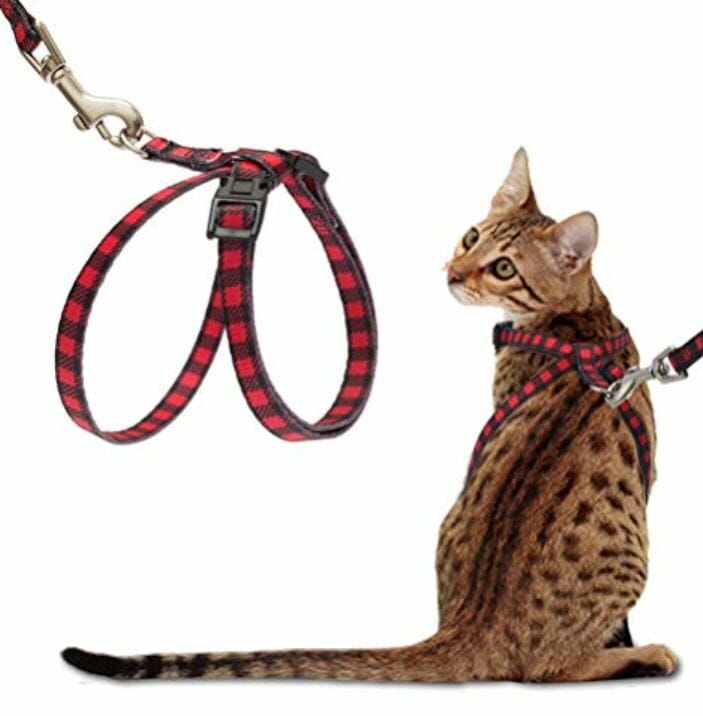It’s best for domesticated cats to stay indoors. By remaining inside your home, these feline companions stay safe, live longer, and avoid dangerous hazards such as coming across wild animals, getting hit by a car, and transmitting infectious diseases. However, if you want your cat to be physically and mentally stimulated, there are ways to let her carefully experience the great outdoors! You can create a catio in your backyard or balcony (read our guide here!), or better yet, take her for a walk outside while sporting a secure yet comfortable cat harness. Walking outside gives your cat a chance to experience new sights, sounds, and smells while bonding with you in a unique but safe way.
To help you get started on an outdoor adventure with your cat bestie, we’ve put together the following for you to read and practise:
- What is a cat harness?
- Why do you need a cat harness?
- What are the types of cat harnesses?
- How do you choose the right harness for your cat?
- How do you make your cat get used to wearing a harness?
- How do you put on a cat harness?
What is a cat harness?
A cat harness is a set of straps and fittings specifically made for feline pets. A pet harness is defined by Wikipedia as “equipment consisting of straps of webbing that loop nearly around—that fasten together using side release buckles—the torso of an animal.”
Meant to control your cat’s movement, cat harnesses are typically made with adjustable straps and come in a wide array of styles, sizes, and colours. A leash can be attached to the body strap or on a D ring that rests between the shoulders.
Why do you need a cat harness?
If you plan on walking your cat on a leash, you must attach it to a cat harness rather than a cat collar. Cats have soft throats, and if you tug on the leash attached to her collar, you may damage your pet’s throat or block her air passageway. Harnesses are also the best option since they are wiggle proof and go securely around your cat’s body.
Aside from using it for cat walks and hikes, you can use a harness if your cat dislikes using carriers in general. For long distance road trips, you can use the harness to let your cat out of her carrier and stretch her legs safely.
What are the types of cat harnesses?
Pawrents keen on taking their cats on outdoor walks can choose from three kinds of harnesses, namely:
H-style harness
When unbuckled, the straps form the letter H. There are two adjustable straps that go around the cat’s neck and waist, then another strap that connects the two. Your cat will have a hard time wiggling out of the H-style harness because of its double loops.

Rogz Alleycat Harness and Lead Set 8mm from My Pet Warehouse
Figure 8 harness
With two loops that go around the cat’s neck and waist, this harness resembles the number 8 when laid on a flat surface. It is designed to give your cat more freedom to move.

PUPTECK Cat Harness with Leash Set from Desert Cart
Vest harness
This harness looks like a sleeveless, close-fitting garment. Depending on the harness design, it can be closed at the belly or back with snaps, buckles, and velcro.

Bond & Co Autumn Cat Harness from Pet Barn
How do you choose the right harness for your cat?
First off, never ever use a dog harness for your cat. Since your cat’s anatomy is different from a dog’s, it’s best to purchase one custom made for their species.
The harness should be comfortably snug around your cat’s body, but still give her full range of movement in her head and leg areas. When worn, you should be able to insert two fingers under the neck and body loops. The adjustable straps should lock securely and not break away like cat collars.
When figuring out the harness size you need, veterinarian Pippa Elliott suggests relying on the chest measurement of your cat. To measure your cat’s chest, place a tape measure around her behind her front legs. Make sure the tape measure doesn’t dig into her fur. Afterwards, add two to three more inches to get your ideal cat harness size. Don’t rely on the size chart because a large could be a medium for another brand. Instead, base it on the actual inches printed on the label.
How do you make your cat get used to wearing a harness?
Before wearing the harness over your cat and taking her out, you must make her get used to it. Depending on their age and disposition, cats will take some time warming up to the idea of wearing a harness and walking outside. You need to be patient and flexible with them for the endeavour to succeed. However, there are ways to make your cat more comfortable with a cat harness:
- Introduce the harness to your kitten as early as possible so she sees this as a “normal” part of her life. Though young kitties are known to be more adaptable, grown-up cats can also learn to accept using harnesses.
- Let your cat get to know the harness by leaving it close to her food bowl or her sleeping space. Allow her to sniff it and make herself more familiar with it.
- Once she’s comfortable with its presence, try draping the harness over her body and observing how she reacts to it. If she doesn’t show signs of stress or annoyance, secure the straps and let her wear it for a few minutes at a time. Increase the duration little by little.
- You can use toys and treats to distract her from it. Remove the harness if she bites, scratches, or tries to remove it.
- Once she’s accustomed to wearing the harness, practice walking her indoors by attaching the leash. Let her feel the weight of the leash by making her walk around with the lead dragging on the floor.
- Have your first outdoor walk in a private and quiet place, such as your backyard. The less stressors for your cat, the better. Prepare her favourite treats and a towel or carrier in case she suddenly gets spooked by something.
How do you put on a cat harness?
Once your cat is familiar with her harness, follow the steps depending on which kind of harness you purchase. When you put it on her for the first time, you can ask for help from another family member. Prepare treats to make it a positive experience for your cat.
H-style harness
- Study the straps and figure out which goes over your cat’s chest and back. As a quick guide, the chest strap is always longer than the back strap.
- Slip your cat’s head through the shorter strap. Make sure the middle strap (the one that holds the two straps) lays flat on your cat’s back.
- Unbuckle the longer strap. Place it around your cat’s chest towards the back of her front legs, then fasten the buckle.
- Check the fit of your cat’s harness. If needed, adjust the strap length through the buckles to make it more comfortable for your cat.
Figure 8 harness
- Study the two straps. Similar to the H-style harness, the shorter loop goes around your cat’s head.
- Slip your cat’s head through the short strap. Make sure the connecting part of the straps sits above your cat’s shoulder blades, not her belly.
- Unbuckle the long strap. Place it around your cat’s chest towards the back of her front legs, then fasten the buckle.
- Check the fit of your cat’s harness. If the loop is too small to fit around your cat’s chest, you can adjust the harness to get some extra length.
Vest harness
- Study the shape of the vest and its straps. The chest strap is longer than the back strap, similar to the H-style and figure 8 harnesses.
- Open the velcro or snaps before wearing it around your cat’s body.
- Position the shorter strap over your cat’s back, and fasten it under her neck.
- Position the longer strap over your cat’s chest, and fasten it behind her front legs.
- Check the fit of your cat’s harness. To make sure that it’s on properly, you can try lifting your cat while holding the D ring.
Make each novel experience for your cat a positive one! If you notice that your cat really isn’t comfortable walking outside with her harness on, adjust your expectations and find another way to bond with her. Also, make sure your cat’s vaccinations are complete before taking her out to reduce the chances of her getting sick from outside elements.
Click here to discover more cat-centric guides and adoption stories from Waldo’s Friends.
Leave a comment
Your email address will not be published. All fields are required.